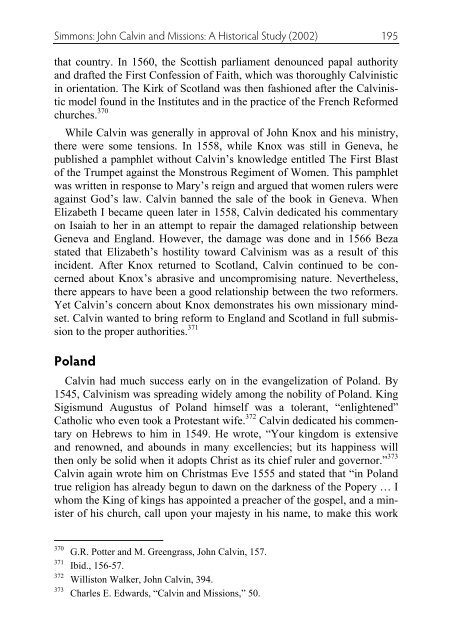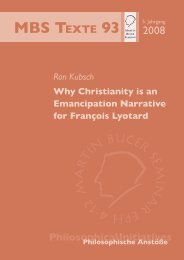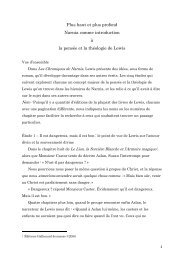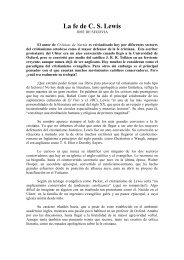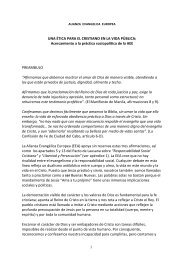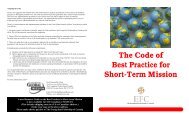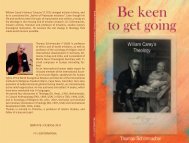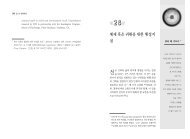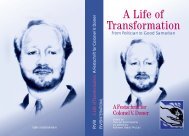Calvin and Missions - World Evangelical Alliance
Calvin and Missions - World Evangelical Alliance
Calvin and Missions - World Evangelical Alliance
Create successful ePaper yourself
Turn your PDF publications into a flip-book with our unique Google optimized e-Paper software.
Simmons: John <strong>Calvin</strong> <strong>and</strong> <strong>Missions</strong>: A Historical Study (2002) 195<br />
that country. In 1560, the Scottish parliament denounced papal authority<br />
<strong>and</strong> drafted the First Confession of Faith, which was thoroughly <strong>Calvin</strong>istic<br />
in orientation. The Kirk of Scotl<strong>and</strong> was then fashioned after the <strong>Calvin</strong>istic<br />
model found in the Institutes <strong>and</strong> in the practice of the French Reformed<br />
churches. 370<br />
While <strong>Calvin</strong> was generally in approval of John Knox <strong>and</strong> his ministry,<br />
there were some tensions. In 1558, while Knox was still in Geneva, he<br />
published a pamphlet without <strong>Calvin</strong>’s knowledge entitled The First Blast<br />
of the Trumpet against the Monstrous Regiment of Women. This pamphlet<br />
was written in response to Mary’s reign <strong>and</strong> argued that women rulers were<br />
against God’s law. <strong>Calvin</strong> banned the sale of the book in Geneva. When<br />
Elizabeth I became queen later in 1558, <strong>Calvin</strong> dedicated his commentary<br />
on Isaiah to her in an attempt to repair the damaged relationship between<br />
Geneva <strong>and</strong> Engl<strong>and</strong>. However, the damage was done <strong>and</strong> in 1566 Beza<br />
stated that Elizabeth’s hostility toward <strong>Calvin</strong>ism was as a result of this<br />
incident. After Knox returned to Scotl<strong>and</strong>, <strong>Calvin</strong> continued to be concerned<br />
about Knox’s abrasive <strong>and</strong> uncompromising nature. Nevertheless,<br />
there appears to have been a good relationship between the two reformers.<br />
Yet <strong>Calvin</strong>’s concern about Knox demonstrates his own missionary mindset.<br />
<strong>Calvin</strong> wanted to bring reform to Engl<strong>and</strong> <strong>and</strong> Scotl<strong>and</strong> in full submission<br />
to the proper authorities. 371<br />
Pol<strong>and</strong><br />
<strong>Calvin</strong> had much success early on in the evangelization of Pol<strong>and</strong>. By<br />
1545, <strong>Calvin</strong>ism was spreading widely among the nobility of Pol<strong>and</strong>. King<br />
Sigismund Augustus of Pol<strong>and</strong> himself was a tolerant, “enlightened”<br />
Catholic who even took a Protestant wife. 372 <strong>Calvin</strong> dedicated his commentary<br />
on Hebrews to him in 1549. He wrote, “Your kingdom is extensive<br />
<strong>and</strong> renowned, <strong>and</strong> abounds in many excellencies; but its happiness will<br />
then only be solid when it adopts Christ as its chief ruler <strong>and</strong> governor.” 373<br />
<strong>Calvin</strong> again wrote him on Christmas Eve 1555 <strong>and</strong> stated that “in Pol<strong>and</strong><br />
true religion has already begun to dawn on the darkness of the Popery … I<br />
whom the King of kings has appointed a preacher of the gospel, <strong>and</strong> a minister<br />
of his church, call upon your majesty in his name, to make this work<br />
370<br />
G.R. Potter <strong>and</strong> M. Greengrass, John <strong>Calvin</strong>, 157.<br />
371<br />
Ibid., 156-57.<br />
372<br />
Williston Walker, John <strong>Calvin</strong>, 394.<br />
373<br />
Charles E. Edwards, “<strong>Calvin</strong> <strong>and</strong> <strong>Missions</strong>,” 50.


